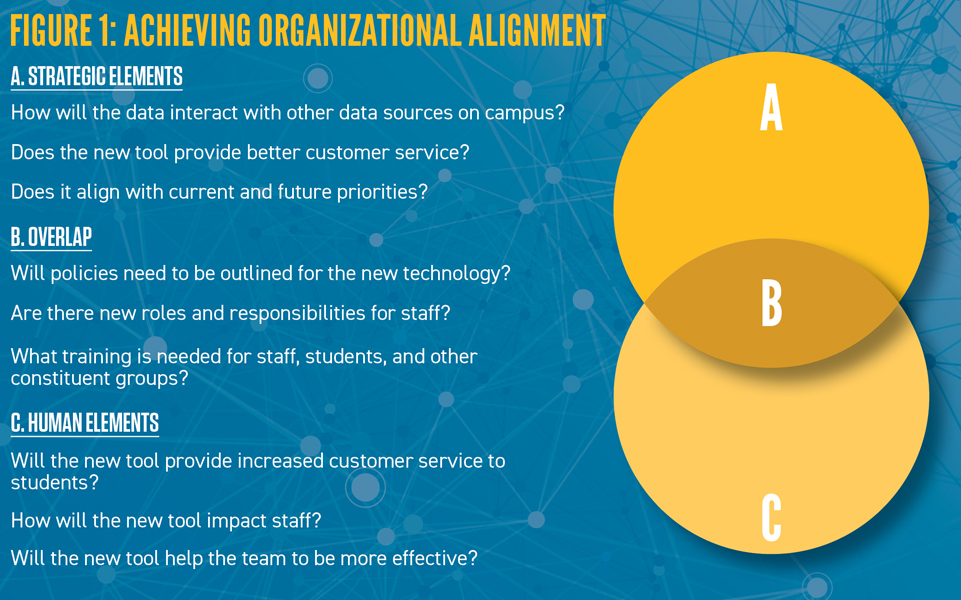NACE Journal, May 2017
Those of us in middle management career services positions—assistant and associate directors—have one foot in vision and strategy and the other in day-to-day operations. We embrace ideas and understand the need to innovate our career services universe. At the same time, we appreciate the vital role we play in leading others.
Yet, the relationship between vision and resources needed to achieve it has not received significant attention. For middle managers, the question is: What role do we play in movements of change? And: How do I manage expectations that are coming from those I lead while meeting the expectations of principal leadership? And, perhaps more importantly: What are the hidden expectations, and how do I find professional development or support?
In terms of professional development, we see many opportunities for career counselors, coaches, and advisers to build expertise and a greater sense of community and connections. Similarly, we see national and international engagements that generally convene principal leaders. In addition, there is programming designed to help those in the middle who aspire to do so to “move up.” But what about excelling as middle managers?
While not a comprehensive roadmap, the intentions of this article are to begin the conversation about and outline advanced strategies for how we can mature in our role as middle managers, and put forth considerations for how we as middle managers can develop an authentic leadership style.
Strategy 1: Achieving Organizational Alignment
Gaining organizational alignment within your department is a foundational step to fully realizing your role as a middle manager. Organizational alignment is the “sweet spot” between the human and strategic elements, often demonstrated by a high level of trust and agility among staff members. Organizational alignment is not an endpoint but rather a process.
Scanning your unit for the current landscape and “temperature”—that is, the attitudes regarding change and goals, plus morale, engagement, and various other elements—is key to achieving organizational alignment. Listening and asking questions are two important techniques to gathering information in implementing this strategy. It may also be helpful to research the history and context of your campus career center. This can be done by reading historical documents and talking to staff and administrators.
During the initial stages of organizational alignment, you have an opportunity to establish a baseline with staff that change is normal; this is also an opportunity to gain agreement on focus and priorities within the department. Consider this example: You are implementing a new technology, such as an online appointment system. Rolling out a new technology that is closely aligned with service delivery needs requires you to engage the voices of internal and external constituencies. (See Figure 1.)
Successfully achieving organizational alignment will provide a strong foundation for you as a leader and for future initiatives.

Strategy 2: Understanding Your Level of Authority
Have a strong understanding and definition of your decision-making power as it relates to the career center. This helps provide clarity around decisions you own and your principal leader owns, and those that require collaboration between the two of you. This underscores the importance of opening up a conversation around decision making and authority with your principal leader and members of the leadership team (if applicable); the result will be less confusion, less miscommunication, and fewer unintended consequences.
Figure 2 illustrates common discussion topics and how leadership might approach decision-making power and authority.
Discussing decision-making and authority upfront with your principal leader will help you with your role and provide insight as to the salient issues that are top of mind for your principal leader.

Strategy 3: Mastering Communication
One skill all leaders must have is the ability to communicate effectively across and through various channels. This is especially critical for those in the middle role, who must communicate “up” and “down.”
Depending on the context of your department and campus, communicating, listening, and translating messages across all levels of the organization can be one of your most time consuming responsibilities. Take advantage of that, and seek opportunities to provide the other perspective. For example, you observe the day-to-day operations and hear from individual contributors regarding their experiences; it is important to bring these stories to leadership and talk through implications that vision setting may have on organizational issues such as staff morale, team dynamics, and workflow.
It is just as important to communicate to individual contributors issues that concern you and principal leadership. For instance, perhaps new initiatives that have gained significant support among the ranks of your direct reports no longer fit within the new vision and priorities. It is incumbent upon you to communicate new directions in terms of both rationale and standards, and, more importantly, value.
Certainly, any multifaceted organization experiences conflict based on issues of communication. It would be negligent not to acknowledge the conflict and multiple roles assistant and associate directors have to assume due to the complexity of messages they receive from above and below. As such, you should continually seek training on mastering the skill of communication. This includes refining skills in negotiation, mediation, motivation, and, where appropriate, accountability.

Strategy 4: Gaining Staff Buy-In
Gaining staff buy-in is a critical step to building a cohesive team with a vision. It involves building trust with the individuals involved. It is crucial for you to be honest about the difficulty of change and to be open to feedback. Depending on the level of change, sometimes an outside facilitator is needed to help lead conversations and gather feedback. Being a keen observer of the dynamics and trust level of your team is important when gauging staff buy-in.
A great way to gain perspective and to build staff buy-in is to ask yourself a few questions, such as:
- Am I showing employees that I understand the difficulties in change, such as a strategy shift or the introduction of new service delivery/technology?
- Am I giving employees the information they need to understand the case for change?
- Are employees being given the opportunity to express and discuss their feelings about change?
- How are staff thoughts about change contributing to decision making?
- Am I providing both practical and interpersonal support as they work out new roles or responsibilities?
Honesty with yourself and with your team is key in gaining staff buy-in. This includes looking at the role staff voices play in decision making as well as how well individuals feel heard.
Strategy 5: Building Your Community of Support
One piece of advice we give to our students is to surround themselves with a community of individuals who will support their professional vision. Those of us in middle roles within career services should adopt this same philosophy.
Building your community of support is a symbolic yet practical professional practice that emphasizes the power of the peer network. In this case, your peer assistant and associate directors at other career services operations across the nation are a huge resource for support and needed perspective. If you don’t already do this, reach out and create formal or informal opportunities to discuss issues on your campus, trends within our profession, or specific case scenarios pertinent to those who serve in middle management positions. There are multiple ways to do this. For example, some state university systems have formal monthly meetings among similarly situated positions. These are generally conference calls or Google Hangouts that create a sense of community and facilitate activities that help colleagues gather data or benchmark information. More importantly, make time to connect with others in the field, even if it just reaffirms that you are not alone. Building your personal community of support will keep you grounded, get you plugged in, and helps you gain long lasting relationships that go beyond professional development. [Editor’s Note: Launched in February 2017, the NACE Community, community.naceweb.org, provides NACE members with the opportunity to connect with peers virtually. NACE also maintains a group on LinkedIn.]
Authenticity Goes a Long Way: Use Your Unique Style of Leadership
It is clear that our profession thirsts for a new kind of leader for the 21st century. Author Bill George of Harvard’s Business School and his colleagues conducted a leadership development study that involved interviewing leaders from different racial, religious, national, and socioeconomic backgrounds to understand what individual contributors want in those who manage and lead them. Their findings: authentic leadership.
Obviously, style of leadership will be contextual based upon the issues ahead and the dynamics of your organization. Remember that having a role in the middle means that you are there to facilitate your team members’ success and to ensure that everyone has the appropriate resources to be not just productive, but also successful. Conversely, being in the middle also requires you to provide leadership and to have the ability to bring great ideas into the overall vision. To synthesize and take leadership guru Mark Sanborn’s words a step further: A leader, even in the middle, leads based on strengths and not a title.
If you are relatively new to your middle position in career services, remember that it is important to learn from principal leaders but not emulate their leadership style. It may be one’s natural orientation to mimic the leadership style of a principal leader, but, as with any relationship you approach, being your honest self will go a long way with those who report to you.
Authentic leadership starts with you. One of the most powerful exercises in developing your unique leadership style is reflecting upon your life story, rather than passively allowing day-to-day activities to consume you without analyzing what you know. Ask yourself: How do I frame this story in ways that allow for me to see what I value and my value in leading others? This exercise is an unending process that can help you develop self-awareness through persistence.

We hope that starting this conversation gets our community thinking about how to invest in the professional and/or skill development of middle management career services professionals.
Certainly, we do not claim to be experts in the space, but hope this will spark further dialogue now and in the future. We invite you to contribute to this discourse, but, more importantly, we encourage you to consider these strategies as you find your voice and refine your authentic leadership style. As we know, it is not a destination, but a journey.
References
Clegg, S., and McAuley, J. “Conceptualising Middle Management in Higher Education: A Multifaceted Discourse.” Journal of Higher Education Policy and Management, 2005, 27(1), 19-34.
Cooper, M.B. and Pardee, H.B. “Managing Conflict from the Middle,” New Directions for Student Services, No. 136, Winter 2011.
George, B., Sims, P., McLean, A., & Mayer, D. (2007, Feb). Discovering Your Authentic Leadership. Retrieved from https://hbr.org/2007/02/discovering-your-authentic-leadership
Hoffman, D. Overview of Strategic Management. (2017). Retrieved from http://danhoffman.wikispaces.com/Table+of+Contents
Hyatt, M. The 5 Markers of Authentic Leadership. Retrieved from https://michaelhyatt.com/the-five-marks-of-authentic-leadership.htm
Lewis, S., and Hayman, R. (April 1, 2015). Leading By Example? Why Leadership Buy-in is Crucial to NGO Exit Strategies. http://www.intrac.org/blog.php/91/leading-by-example-why-leadership-buy-in-is-crucial-to-ngo-exit-strategies
Mather, P.C. Bryan, S.P., and Faulkner, W.O. “Orienting Mid-Level Student Affairs Professionals.“ College Student Affairs Journal, 2009, 27(1), 242-256.
Pierce, A.R., and James, S.R. (January 2006). The 10 Keys to Effective Supervision: A Developmental Perspective. https://www.yumpu.com/en/document/view/8270014/the-10-keys-to-effective-supervision-rising-sun-consultants-llc.
Sanborn, M. (2006). You don't need a title to be a leader. New York, NY: Crown Publishing.




